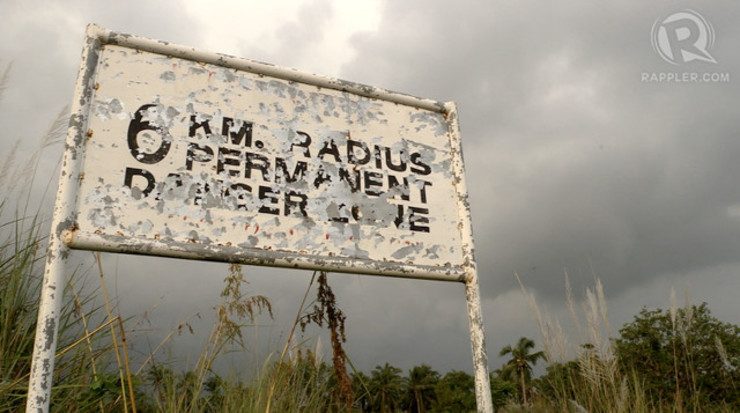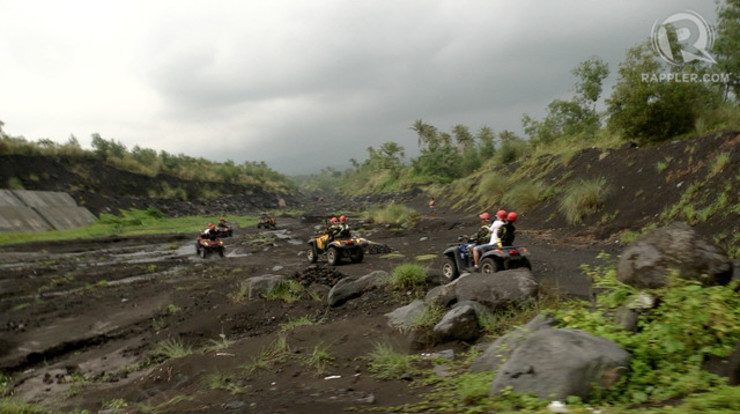SUMMARY
This is AI generated summarization, which may have errors. For context, always refer to the full article.

They are well within the 6-kilometer danger zone, which since September 15, is supposed to be off-limits to everyone but patrolling military personnel.
But for kangkong farmer Grace Mirandilla, there are other things to worry about besides an exploding volcano.
She has two young mouths to feed at home and a plot of land that provides their only source of income.
“Dito po yung taniman namin, mga gulay. Wala naman kaming ibang pagtataniman ng gulay, dito lang talaga,” she said. (This is where we plant our vegetables. There’s no other place for us to plant our vegetables but here.)
Around 70% of Albay’s more than 50,200 evacuees depend on livelihood inside Mayon’s danger zone.
Along with her sister, also with children of her own, they gather kangkong stalks, distinctly green on top of the ebony soil, and wash them in the rivulets of stream that flow through the lahar corridor.
They will sell their tenderly maintained vegetables to villages just beyond the danger zone or to trucks that continue to pass through the lahar corridor.
Mirandilla is just one of the thousands of Albayanons who make a living at the foot of the country’s most active volcano, tending crops or cattle. (READ: State of calamity in cities, towns around Mayon)
Those living within the 6-kilometer danger zone are now in evacuation centers in different parts of the province. But of the more than 50,200 evacuees, around 70% have livelihoods inside the danger zone, said Office of Civil Defense Region 5 Director Raffy Alejandro.
“Those are the farmers. Those are the ones who go back and forth daily to their farms. We’re trying to encourage them not to enter. That’s one of our problems because, for those in the evacuation center, this is their only source of livelihood,” he said on Friday, October 3. (READ: Albay needs P118M a month for Mayon evacuation)
Many of them leave their wives and children in the evacuation centers to continue tending their fields or grazing their animals, unwilling to leave their source of livelihood hostage to the volcano’s unpredictable wrath.
“It’s usually the men going back and forth. That’s why if you go to evacuation centers during the day time, most of the ones there are women. The men really go back because we still need to account for some 4,000 animals. That’s what they keep coming back for,” explained Alejandro.
Leaving Mayon
Most of the time, it’s the father and the eldest son who make the daily trips to the danger zone, an invisible population that could be as many as 1,000, said Alejandro.
To solve this problem, one of the biggest obstacles to meeting the province’s zero-casualty goal, the provincial and national government will try to wean off the farmers from their land, at least temporarily, by providing them alternative sources of income.
As many as 1,000 may be entering and exiting the 6-kilometer danger zone daily.
“Those with skills are going to be given food for work to help in rattan-making, for the women,” said Alejandro.
But it’s a bit trickier finding alternative work for the men who are mostly farmers and know only how to work the land.
“The cluster in charge of that is DTI (Department of Trade and Industry) and TESDA (Technical Education and Skills Development Authority). They will come up with the proposal,” he said.
A cash-for-work program will be implemented by the Department of Social Welfare and Development next week, a shift from the current focus of providing relief for the evacuees in the form of rice and viands.
Mirandilla is fully aware of the danger she and her family face while living within the danger zone. But it’s a risk she’s willing to take because they have a plan B.
“Takot naman po pero nagdadasal na lang para sa kaligtasan. Kung biglang um-erupt yung Mayon, aalis kami sa Gogon po, sa sinabing evacuation [center].”
(We are scared but we just pray for our safety. If Mayon suddenly erupts, we will leave for Gogon, in the evacuation center there.)
Gogon, one of the villages in Legazpi City, is far from the danger zone and close to the city center, said Mirandilla.

Once they are told that Mayon has reached level 4 – when persistent ground tremors and earthquakes are felt and glowing lava can be seen in the crater – they will leave immediately. (READ: Mayon ‘relaxing before full-blown explosion’)
Mayon’s moods
She is banking on what is so far known about Mayon’s behavior, that a smaller eruption precedes a more destructive one.
But the time it takes for the bigger eruption, called a vulcanian eruption, to happen after the smaller eruption could be days or hours, said Governor Joey Salceda in a press conference earlier that day.
Once the vulcanian eruption happens, anyone inside the danger zone is at risk of being hit by pyroclastic flow, a dense mass of very hot ash, lava fragments and gases expelled from the crater in a hazardous eruption.
“Our scientists say the speed of pyroclastic flow can go as fast as 300 kilometers per hour so if you’re inside and it’s a vulcanian eruption, you will be hit wherever you are inside,” said brigade commander Colonel Raul Farnacio.
Years living at the foot of Mayon has taught 36-year-old Mirandilla how to read the volcano’s many moods.
For now, she trusts the volcano will still allow her to harvest her vegetables in peace. After all, the same lahar that once struck fear in the hearts of her people continues to give her family life. – Rappler.com
Add a comment
How does this make you feel?
There are no comments yet. Add your comment to start the conversation.